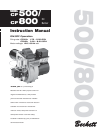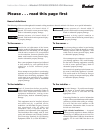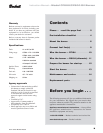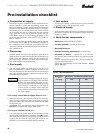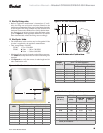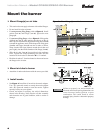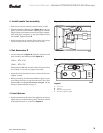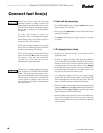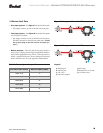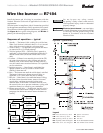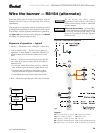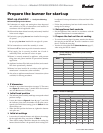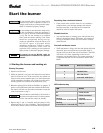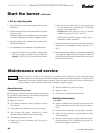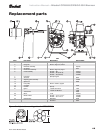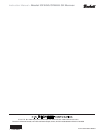
14
Form 6104 BCF5-R0301
Instruction Manual – Model CF500/CF800 Oil Burner
Maintenance and service
The burner must be serviced at least annually by a qualified service technician to assure continued reliable
operation. Operation and adjustment of the burner requires technical knowledge and the use of combustion test
instruments. Do not tamper with the burner or controls. Failure to comply could result in failure of the burner or
system, resulting in severe personal injury, death or substantial property damage.
Monthly maintenance
— by owner
❏ Observe combustion air openings and vent system for
integrity. Openings must be clean and free of obstruc-
tions.
❏ Check oil lines and fittings to verify there are no leaks.
❏ Observe burner ignition and performance to verify
smooth operation.
❏ Shut the system down if you observe abnormal or ques-
tionable operation. Call a qualified service agency for
professional inspection and service.
Annual service
— by qualified service technician
Have the burner inspected, tested and started at least annually
by a qualified service technician. This annual test/inspection
should include at least the following:
❏ Replace oil nozzle.
❏ Clean burner and blower wheel (if needed to remove
lint or debris).
❏ Test ignition and combustion and verify air settings.
❏ Test oil supply line vacuum - verify that it is within
allowable range indicated in fuel unit literature.
❏ Check pump pressure to nozzle.
❏ Inspect fuel system (including tank, lines and all
connections).
❏ Inspect combustion air and vent systems.
❏ Replace oil filter.
❏ Oil motor (if not permanently lubricated).
Start the burner continued
❏ Set air adjusting plate
1. Allow the burner to run until the appliance has warmed
sufficiently.
2. Visually check the flame. The flame should not be dark
orange or smoky.
If the flame appears to be smoking, increase the amount
of air by re-adjusting the air band to a higher number.
3. Once the appliance has warmed, the air setting can be
checked and adjusted.
4. Use combustion test instruments to adjust the burner.
a. Adjust the air until a trace of smoke is achieved with
CO
2
level as high as possible (lowest possible O
2
).
Example: 13.5% CO
2
(2.5% O
2
) with a trace of smoke.
b. Increase the air to reduce CO
2
by 2 percentage points
at a zero smoke level. (Increase O
2
by 3 percentage
points at a zero smoke level.)
Example: Reduce CO
2
from 13.5% to 11.5%, with zero
smoke (or increase O
2
from 2.5% to 5.5%).
c. This procedure provides a margin of reserve air to ac-
commodate variable conditions.
5. Check the breech draft pressure against the appliance
manufacturer’s recommended setting (typically + 0.1"
W.C.).
6. If the breech pressure is higher or lower than recommended
level, adjust the appliance breech damper to achieve the
specified setting. Recheck the smoke and CO
2
levels. Ad-
just burner air if necessary.



